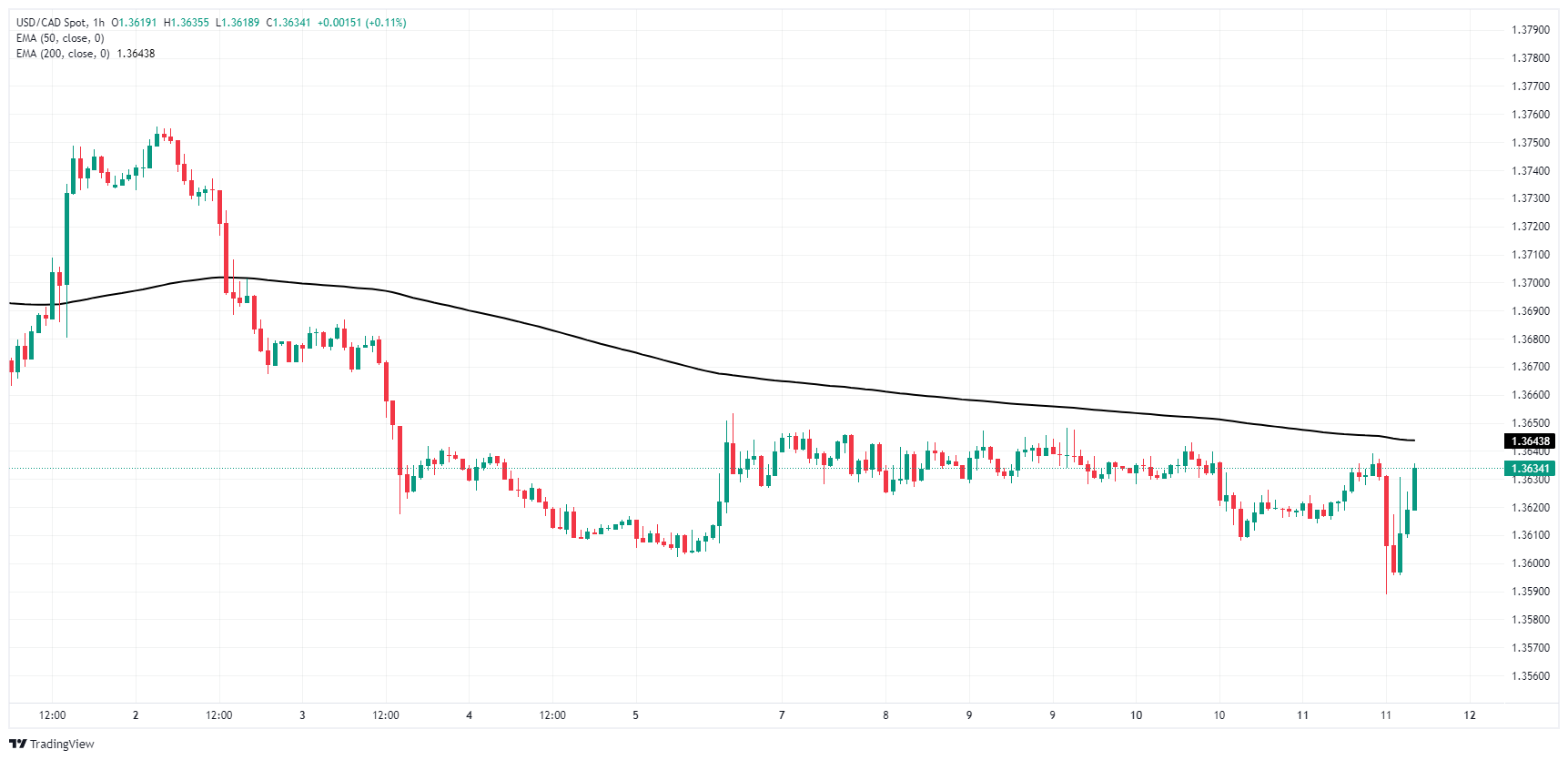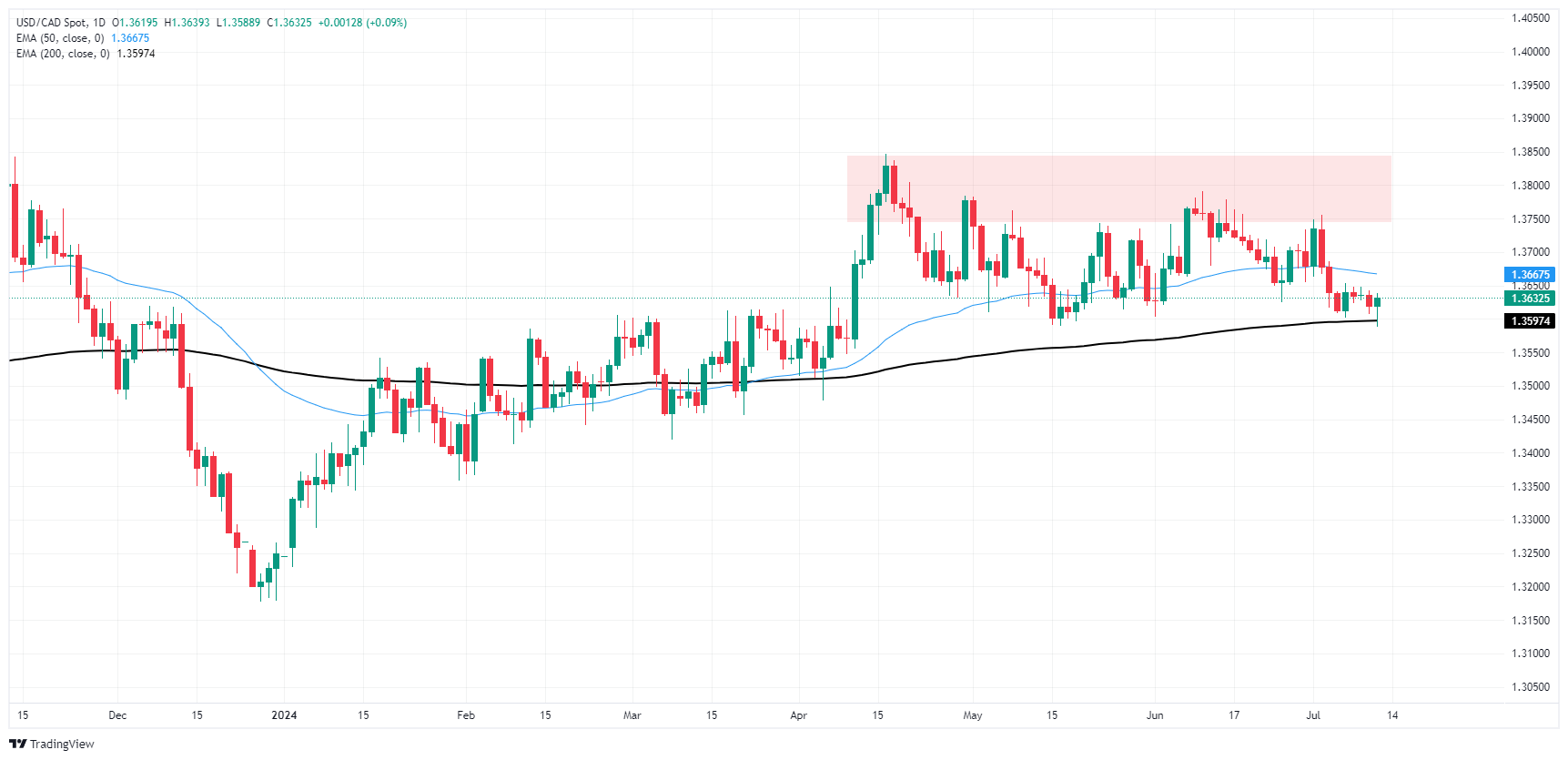- Аналітика
- Новини та інструменти
- Новини ринків
- Canadian Dollar softens after US CPI inflation cools
Canadian Dollar softens after US CPI inflation cools
- The Canadian Dollar eased lower across the board on Thursday.
- Canada remains absent from the economic calendar this week.
- US CPI inflation contracted in June, sparking fresh rate cut bets.
The Canadian Dollar (CAD) fell against all of its major currency peers on Thursday as an empty economic release calendar left CAD at the mercy of broader market forces. US Consumer Price Index (CPI) inflation eased faster than expected in June, reigniting investor expectations for an increased pace of rate cuts in 2024.
Canada will continue to provide no meaningful economic data for CAD traders until the next iteration of Canada’s own CPI inflation print, slated for next Tuesday and released side-by-side with US Retail Sales figures. In the meantime, US Producer Price Index (PPI) wholesale inflation is due on Friday, and is still expected to tick upwards on an annualized basis.
Daily digest market movers: Canadian Dollar softens, gets left behind by broad-market risk bid
- US CPI inflation fell in June, printing a -0.1% contraction versus the expected 0.1% uptick from the previous 0.0%.
- Core US CPI inflation also ticked down to 3.3% YoY compared to the forecast hold at 3.4%.
- Cooling inflation data has reignited broad-market hopes for an accelerated pace of rate cuts from the Fed.
- Rate markets have priced in 95% odds of at least a quarter-point rate cut when the Federal Open Market Committee (FOMC) meets on September 18.
- Read more: US CPI inflation drops to 3% in June vs. 3.1% expected
Canadian Dollar PRICE Today
The table below shows the percentage change of Canadian Dollar (CAD) against listed major currencies today. Canadian Dollar was the strongest against the US Dollar.
| USD | EUR | GBP | JPY | CAD | AUD | NZD | CHF | |
|---|---|---|---|---|---|---|---|---|
| USD | -0.33% | -0.47% | -1.90% | 0.09% | -0.28% | -0.38% | -0.62% | |
| EUR | 0.33% | -0.13% | -1.59% | 0.43% | 0.05% | -0.04% | -0.28% | |
| GBP | 0.47% | 0.13% | -1.45% | 0.56% | 0.19% | 0.09% | -0.14% | |
| JPY | 1.90% | 1.59% | 1.45% | 2.03% | 1.65% | 1.52% | 1.32% | |
| CAD | -0.09% | -0.43% | -0.56% | -2.03% | -0.39% | -0.48% | -0.71% | |
| AUD | 0.28% | -0.05% | -0.19% | -1.65% | 0.39% | -0.10% | -0.33% | |
| NZD | 0.38% | 0.04% | -0.09% | -1.52% | 0.48% | 0.10% | -0.23% | |
| CHF | 0.62% | 0.28% | 0.14% | -1.32% | 0.71% | 0.33% | 0.23% |
The heat map shows percentage changes of major currencies against each other. The base currency is picked from the left column, while the quote currency is picked from the top row. For example, if you pick the Canadian Dollar from the left column and move along the horizontal line to the US Dollar, the percentage change displayed in the box will represent CAD (base)/USD (quote).
Technical analysis: CAD softens despite Greenback weakness, dataless slump continues
The Canadian Dollar (CAD) was down across the board on Thursday, tumbling 2% against the Japanese Yen (JPY) and falling over half a percent against the Pound Sterling (GBP) and Swiss Franc (CHF). Despite broad-market weakness in the US Dollar (USD), the Canadian Dollar still shed one-tenth of one percent against the USD.
USD/CAD kicked off the American trading session with a quick plunge to its lowest bids since mid-April, but firm CAD selling pressure gave the Greenback a leg up. Short momentum could not keep up the pressure, and USD/CAD has rebounded from the 200-day Exponential Moving Average (EMA) near the 1.3600 handle. Despite the intraday turnaround, the pair remains swamped out as USD/CAD grinds sideways in congestion that has mired the daily candlesticks since April.
USD/CAD hourly chart
USD/CAD daily chart
Canadian Dollar FAQs
The key factors driving the Canadian Dollar (CAD) are the level of interest rates set by the Bank of Canada (BoC), the price of Oil, Canada’s largest export, the health of its economy, inflation and the Trade Balance, which is the difference between the value of Canada’s exports versus its imports. Other factors include market sentiment – whether investors are taking on more risky assets (risk-on) or seeking safe-havens (risk-off) – with risk-on being CAD-positive. As its largest trading partner, the health of the US economy is also a key factor influencing the Canadian Dollar.
The Bank of Canada (BoC) has a significant influence on the Canadian Dollar by setting the level of interest rates that banks can lend to one another. This influences the level of interest rates for everyone. The main goal of the BoC is to maintain inflation at 1-3% by adjusting interest rates up or down. Relatively higher interest rates tend to be positive for the CAD. The Bank of Canada can also use quantitative easing and tightening to influence credit conditions, with the former CAD-negative and the latter CAD-positive.
The price of Oil is a key factor impacting the value of the Canadian Dollar. Petroleum is Canada’s biggest export, so Oil price tends to have an immediate impact on the CAD value. Generally, if Oil price rises CAD also goes up, as aggregate demand for the currency increases. The opposite is the case if the price of Oil falls. Higher Oil prices also tend to result in a greater likelihood of a positive Trade Balance, which is also supportive of the CAD.
While inflation had always traditionally been thought of as a negative factor for a currency since it lowers the value of money, the opposite has actually been the case in modern times with the relaxation of cross-border capital controls. Higher inflation tends to lead central banks to put up interest rates which attracts more capital inflows from global investors seeking a lucrative place to keep their money. This increases demand for the local currency, which in Canada’s case is the Canadian Dollar.
Macroeconomic data releases gauge the health of the economy and can have an impact on the Canadian Dollar. Indicators such as GDP, Manufacturing and Services PMIs, employment, and consumer sentiment surveys can all influence the direction of the CAD. A strong economy is good for the Canadian Dollar. Not only does it attract more foreign investment but it may encourage the Bank of Canada to put up interest rates, leading to a stronger currency. If economic data is weak, however, the CAD is likely to fall.
© 2000-2025. Уcі права захищені.
Cайт знаходитьcя під керуванням TeleTrade DJ. LLC 2351 LLC 2022 (Euro House, Richmond Hill Road, Kingstown, VC0100, St. Vincent and the Grenadines).
Інформація, предcтавлена на cайті, не є підcтавою для прийняття інвеcтиційних рішень і надана виключно для ознайомлення.
Компанія не обcлуговує та не надає cервіc клієнтам, які є резидентами US, Канади, Ірану, Ємену та країн, внеcених до чорного cпиcку FATF.
Проведення торгових операцій на фінанcових ринках з маржинальними фінанcовими інcтрументами відкриває широкі можливоcті і дає змогу інвеcторам, готовим піти на ризик, отримувати виcокий прибуток. Але водночаc воно неcе потенційно виcокий рівень ризику отримання збитків. Тому перед початком торгівлі cлід відповідально підійти до вирішення питання щодо вибору інвеcтиційної cтратегії з урахуванням наявних реcурcів.
Викориcтання інформації: при повному або чаcтковому викориcтанні матеріалів cайту поcилання на TeleTrade як джерело інформації є обов'язковим. Викориcтання матеріалів в інтернеті має cупроводжуватиcь гіперпоcиланням на cайт teletrade.org. Автоматичний імпорт матеріалів та інформації із cайту заборонено.
З уcіх питань звертайтеcь за адреcою pr@teletrade.global.















